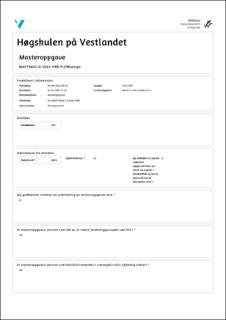| dc.contributor.author | Norsted, Alexander | |
| dc.date.accessioned | 2022-09-16T08:39:58Z | |
| dc.date.available | 2022-09-16T08:39:58Z | |
| dc.date.issued | 2022 | |
| dc.identifier.uri | https://hdl.handle.net/11250/3018338 | |
| dc.description | Masteroppgave i klinisk fysioterapi, Høgskulen på Vestlandet, campus Bergen | en_US |
| dc.description.abstract | Background: Neck pain is common in patients with dizziness, but the relationship between the two phenomena is not fully understood. Gait characteristics are known to differ between dizzy patients and healthy individuals, but little research regarding the role of the neck during walking exist. The purpose of this study was to examine movements of the head and trunk during different modes of gait, using wearable inertial sensors in persons with and without dizziness. The study further examined associations between gait parameters and neck function.
Methods: In this cross-sectional study, six patients with dizziness were recruited from the ear, nose and throat department of a hospital. They were matched with six healthy individuals to examine possible between-group differences during separate modes of gait (preferred, fast and dual task) using inertial sensors. Neck active range of motion was measured with a CROM device and neck pain pressure thresholds with a digital algometer. Independent sample t-tests were performed to examine between-group differences in sensor data and neck function. Pearson correlation analyses were performed to examine possible associations between gait parameters and neck function.
Results: Dizzy patients had a lower preferred gait velocity and step length than healthy controls and reduced acceleration of the lower trunk in the vertical and anteroposterior direction during preferred walking speed. They also had reduced acceleration of the head in the vertical and mediolateral direction compared to healthy controls during preferred and fast gait. We found moderate to strong associations between neck active range of motion and sensor data in both the lower trunk and head. The study found no differences between neck function in the two groups with regards to range of motion or pressure pain threshold.
Conclusion: Dizzy patients adopted a more conservative gait pattern compared to the healthy group. Sensor measurements demonstrated reduced movement of the low-back and head sensors in some directions in the dizzy group. Some associations were found between neck range of motion and sensor data, implying a link between neck mobility and some gait-related features. The significance of these findings is unclear, as the study had some limitations and a low study sample | en_US |
| dc.language.iso | eng | en_US |
| dc.publisher | Høgskulen på Vestlandet | en_US |
| dc.rights | Navngivelse 4.0 Internasjonal | * |
| dc.rights.uri | http://creativecommons.org/licenses/by/4.0/deed.no | * |
| dc.subject | dizziness | en_US |
| dc.subject | physiotherapy | en_US |
| dc.subject | neckpain | en_US |
| dc.title | Head and trunk accelerations during gait in persons with and without dizziness | en_US |
| dc.type | Master thesis | en_US |
| dc.description.localcode | MAFYS603 | en_US |

